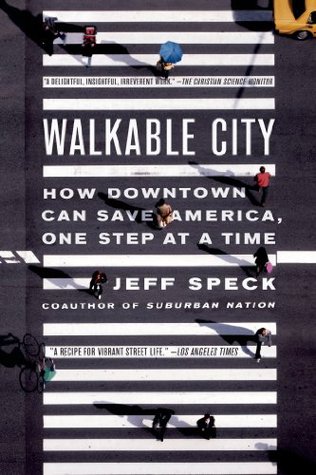More on this book
Community
Kindle Notes & Highlights
by
Jeff Speck
Read between
September 30 - October 2, 2016
Get walkability right and so much of the rest will follow.
In the absence of any larger vision or mandate, city engineers—worshiping the twin gods of Smooth Traffic and Ample Parking—have turned our downtowns into places that are easy to get to but not worth arriving at.
The General Theory of Walkability explains how, to be favored, a walk has to satisfy four main conditions: it must be useful, safe, comfortable, and interesting.
Comparison of walkable cities and auto-dependent suburbs yields some eye-opening statistics—for example, that transit users are more than three times as likely as drivers to achieve their CDC-recommended thirty minutes of daily physical activity.
Increasingly, it is becoming clear that the American health-care crisis is largely an urban-design crisis, with walkability at the heart of the cure.
A third, in San Diego, reported that 60 percent of residents in a “low-walkable” neighborhood were overweight, compared to only 35 percent in a “high-walkable” neighborhood.
Alan Durning, who analyzed the combined risk of dying from two causes—traffic crashes and crime—in Seattle, Portland, and Vancouver, British Columbia. He found that, on average, if you add the two factors together, you are 19 percent safer in the inner city than in the outer suburbs.
In 2004, a meta-analysis of dozens of previous studies found that “on average, a 10 percent increase in lane miles induces an immediate 4 percent increase in vehicle miles traveled, which climbs to 10 percent—the entire new capacity—in a few years.”
While the cost of the trip will rarely keep us home, the threat of being stuck in traffic often will, at least in our larger cities. Congestion saves fuel because people hate to waste their time being miserable.
“Beyond a certain speed, motorized vehicles create remoteness which they alone can shrink. They create distances for all and shrink them for only a few.”
Shoup calculates that “the cost of all parking spaces in the U.S. exceeds the value of all cars and may even exceed the value of all roads.”
cities and other sponsors keep parking prices artificially low. Because there are so many parking spaces, this cumulative subsidy was calculated a decade ago at between $127 billion and $374 billion a year,8 which puts it in the range of our national defense budget.
Nobody can opt out of paying for parking. People who walk, bike, or take transit are bankrolling those who drive. In so doing, they are making driving cheaper and thus more prevalent, which in turn undermines the quality of walking, biking, and transit.
Developers in San Francisco estimate that the city’s one-space-per-unit requirement adds 20 percent to the cost of affordable housing. Shoup calculates that eliminating this requirement would allow 24 percent more San Franciscans to buy homes.
A study of six different urban sites found that roughly a third of all traffic congestion was made up of people trying to find a parking spot.
In another poll, the devoutly nonideological Consumer Preference Survey, respondents favored public transportation over road building as a solution to congestion by almost three to one.● The actual funding allocation currently favors roads four to one over transit,9 so it would seem that a major correction is in order.
Generally speaking, the cities with the smallest blocks are the ones best known for walkability, while those with the largest blocks are known as places without street life—if they are known at all. The preindustrial neighborhoods of downtown Boston and lower Manhattan, like their European counterparts, have blocks that average less than two hundred feet long (and the cranky medieval street patterns to match). The most walkable grids, like Philadelphia’s and San Francisco’s, have blocks that average less than four hundred feet in length. And then there are the pedestrian-free zones, like
...more
All told, a doubling of block size corresponded with a tripling of fatalities.
As any London pedestrian will tell you, a twenty-mph sign does not a twenty-mph driver make. Most motorists drive the speed at which they feel comfortable, which is the speed to which the road has been engineered.
Risk homeostasis describes how people automatically adjust their behavior to maintain a comfortable level of risk. It explains why poisoning deaths went up after childproof caps were introduced—people stopped hiding their medicines—and why the deadliest intersections in America are typically the ones you can navigate with one finger on the steering wheel and a cellphone at your ear.
What makes a sidewalk safe is not its width, but whether it is protected by a line of parked cars that form a barrier of steel between the pedestrian and the roadway.
Canada’s Yukon Territory—up there next to Alaska—has twice the rate of bicycle commuters as California.
The ecologist E. P. Odum argued that it was not grassland or forest that provided the ideal early habitat for humans, but rather the boundary between the two, the “forest edge,” where both distant views and physical enclosure were present. Thomas Campanella of the University of North Carolina notes that the “recollection of the forest edge may explain why architectural and urbanistic elements evocative of this space—colonnades, loggias, arcades, verandas, even porches—are so appealing and comfortable.”
According to the U.S. Department of Agriculture, the cooling impact of a single healthy tree “is equivalent to ten room-size air conditioners operating 24 hours a day.”
A properly shaded neighborhood is said to require 15 to 35 percent less air conditioning than a treeless one.
Finally, in their quest to become more sustainable, cities need to remember that, for the typical pedestrian, the most mundane storefront is still more interesting than the most luxuriant landscape.


